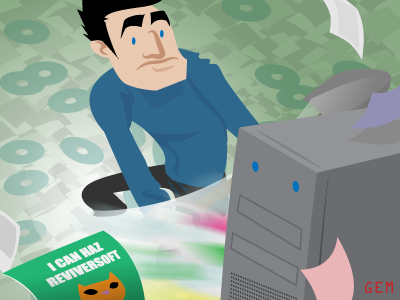| Pyrimme paikallistaa sivuillamme niin monella kielellä kuin mahdollista, mutta tämä sivu on tällä hetkellä kone Google-kääntäjän avulla. | lähellä |
-
-
tuotteet
-
resurssit
-
tuki
-
yritys
-
All About kiintolevyt ja tietosi – Vinkkejä Rantz HoseleyAll About Hard Drives and Your Data – Tips from Rantz Hoseley
Mennessä Steve Horton Marraskuu 23, 2011guest blog, hard drives, rantz hoseleyEi kommentteja
Rantz Hoseley
Vietin enemmän aikaa tähän peliin kuin mikään muu: SSX3. Olen valittanut SSX-franchisen puuttumista 360: lla, ja odotan todellakin innokkaasti uuden pelin saapumista, kuten en ole missäänkään pelissä yli kymmenen vuoden ajan.
Halusinko koskaan heittää tietokoneeni ikkunasta? Usein. Usein. Pahinta oli, kun meillä oli esitys Sonyn päämiehille Star Trek -pelin hyväksymiseksi, jonka teimme PSP: lle. Vietimme 38 tuntia suoraan saadaksesi uusia Romulan-laivamalleja rakennettaviksi, kuvioituiksi ja pelissä … Ja kärsimme massiivisen sähkökatkon, joka kesti pidempään kuin UPS-laitteemme. Olen ehkä itkennyt vähän.
Rantz Hoseley on työskennellyt tarinoiden kerronnassa sarjakuvien, proosa- ja videopelien kautta yli 25 vuotta työskennellyt tuotemerkeillä, kuten Star Trek ja Disneyn Aladdin. Hän takaa parhaillaan uusia alueita digitaalisten kertomusten maailmassa LongBox, Inc. -yrityksellään.
Olen työskennellyt videopeliteollisuudessa ja monissa ohjelmistokehitysyrityksissä jo 17 vuotta ja työskennellyt “huippuluokan” tietokoneiden kanssa asettelun ja grafiikan tuotannossa 5 vuotta ennen sitä. Tämä pähkinänkuoressa tekee minusta ihmisen, jonka ystävät, lapset, lasteni opettajat ja satunnaiset ihmiset kysyvät “kuinka korjata heidän tietokoneensa”. Tämä avunpyyntö alkaa melkein aina sanoilla “En tiedä paljon tietokoneista” tai siihen liittyvässä lausunnossa: “En ole kiinnostunut pelaamaan niitä Warcrafty-pelejä, haluan vain, että järjestelmäni ei olisi niin hidas koko ajan. ” Olen selittänyt heille monta kertaa, ja nyt, rakas lukija, sinulle, että on olemassa joitain avaintoimintoja, joita “pelaajat” käyttävät sujuvan käyttöjärjestelmän ylläpitämisessä. Näin varmistetaan, että edes Excel-laskentataulukoiden kaikkein verottavampi ei torju heidän järjestelmään.
Russ Pitts on jo käsitellyt joitain tärkeitä tietoja tietokoneesi “puhtaana pitämisestä”, jotka löytyvät täältä (lisää linkki). Jos et ole vielä lukenut niitä, kehotan sinua tekemään niin. Mene eteenpäin, olen täällä kun palaat takaisin.
Nyt puhutaan kiintolevyistä, tärkeästä sisällöstäsi ja sinusta.
Russ kattoi jo SSD vs. levyasemien tekniset edut ja kuinka tärkeätä on kopion tekeminen kaikista tärkeistä tiedostoistasi ja mieltymyksistäsi, ennen kuin asetat uuden kiintolevyn tai alustat nykyisen, mutta (en voi korostaa tätä tarpeeksi), että sinulla on jatkuva, useille tietokoneille päästävä sijainti kriittisille tiedostoillesi, jotka EI sijaitse tietokoneesi teräväpiirtotelevisiossa, voi tarkoittaa eroa tuottavuuden ja sen välillä, että päästät tuskallisuudesta banshee-tasolla, kun etsit lähintä raskasta esinettä, johon tietokoneesi on löydettävä. Usein vastaus tähän on “No, minulla on vain yksi tietokone, joten minun ei tarvitse päästä tiedostoihini toisella koneella.” Avain tähän on ymmärtäminen ja valmistautuminen siihen, että tietokoneet (ja niihin liittyvät komponentit) rikkoutuvat. Kaikki. . Aika. Tuo TRS-37: n vuoden loppuraportti, jota olet orjannut 2 kuukautta suoraan? Joka olet työskennellyt sillä tietokoneella, jolla sinulla on? Mitä tapahtuu, jos tietokoneen HD epäonnistuu? Tai se vioittuu, ja joudut alustamaan (parhaimmillaan) koko asian? Onneksi on olemassa useita hyviä (ja mikä tärkeintä, erittäin edullisia vaihtoehtoja), jotta tämä ei tapahdu sinulle.
(Ja kyllä, puhun täällä kokemuksesta. Kivulias, säkkikangas ja tuhkaa surun tyyppinen kokemus. Opi kipustani.)
Kun aloin työskennellä ohjelmistoliiketoiminnassa, löysin varmuuskopioiden “iloa”. Tämä tapahtui vuonna 1994, ja silloin tiedostojen ja sisällön ulkoisen varmuuskopioinnin tekeminen tarkoitti keskipalvelimen käyttämistä, joka käytti tietokoneellasi erittäin kalliita ohjelmistoja määrättyyn aikaan, koneen haltuun ottamista kaiken sisällön kopioimiseksi ja renderointia tietokone ei kykene tekemään muuta muuta seuraavien tuntien ajan, kun varmuuskopioita tapahtui. Onneksi olemme siirtyneet ohi. Jokaiseen Windows XP: tä myöhemmässä PC-käyttöjärjestelmässä on sisäänrakennettu “varmuuskopio” -apuohjelma, jonka avulla voit määrittää nimettyjen tiedostojen ja hakemistojen ulkoisen varmuuskopion tietyllä hetkellä ulkoiselle HD-levylle. Muistettavat varmuuskopioita tehtäessä:
- Älä varmuuskopioi kaikkia tiedostoja. Tämä ei pelkästään hidasta varmuuskopiointiprosessia, vaan lopputuloksena on metrinen digitaalinen määrä “cruft-“, temp-tiedostoja ja materiaalia, joka tapahtuu normaalissa päivittäisessä prosessissa verkkosivujen, sähköpostien ja materiaalien lataamiseen. Varmuuskopioi vain projektisi / siinä on oltava kansioita, samoin kuin “käyttäjä” -hakemistosi (joissa yleensä on valintasi, ja sen sisältämät kohteet, kuten sähköpostitiedostot, kirjanmerkit ja liitteet). Tämän alajoukko on:
- Kun et käytä tietokonetta päivittäin, älä tallenna tiedostoja ja asiakirjoja Omat tiedostot -hakemistoon. Tämän lisäksi tiedostojen ja asiakirjojen varmuuskopiointi vaikeutuu, koska joudut etsimään kohteita käyttäjähakemistoissa, ja se johtaa myös sotkeutuvaan sekoitukseen tiedostoja ja asiakirjoja, jotka haluat olla, ja tiedostoja, jotka ovat tulleet liitteinä tai temp-tiedostot, joita vain katsoit, mutta joilla ei ole kiinnostusta pitää yllä. Kaikkien tietokoneeni hakemistorakenne on: D: / Docs / Business (tai “Writing” tai “School” jne. Toisella tasolla.) Kyllä, se on “D”, ei “C”; päästämme hetkeksi ‘miksi’ -kohtaan.
Kun tiedostojasi on asetettu kriteerikeskeisiin hakemistoihin, se tekee materiaalin löytämisen helpommaksi, kun käsittelet sitä, mutta antaa sinulle myös mahdollisuuden helposti kopioida ulkoisen varmuuskopion rakenne. Ulkoiset varmuuskopiot näyttävät samanlaisilta kuin “D” -asema, hakemistojen “Asiakirjat”, “Kuvat”, “Viihde” ja vastaavat kanssa. Tämän avulla voin helposti asettaa automaattisen varmuuskopion (järjestelmätyökaluilla) tai vetää ja pudottaa koko rakenteen ulkoiseen USB-liitettyyn HD-muotoon.
- Nyt saatavana olevan ulkoisen HD: n käytön lisäksi on monia vaihtoehtoja. Pilvestä on paljon puhuttelua ja hypeä, kun kyse on tietokoneista ja mobiililaitteista, ja hyvästä syystä. Aineiston säilyttäminen ulkoisella palvelimella ja pääsy siihen tietokoneella, tablet-laitteella tai älypuhelimella on uskomattoman kätevää ja voi lisätä tuottavuutta huomattavasti. Se on myös erittäin tehokas tapa tehdä tärkeän materiaalin kriittisiä varmuuskopioita varmistamalla, että riippumatta siitä, mitä tapahtuu tietokoneellesi, sinulla on helppo pääsy näihin tiedostoihin ja asiakirjoihin. Kaksi nykyistä johtavaa palvelua ovat Dropbox ja iCloud. Dropboxilla on etuna se, että työskentelet useammalla laitteella ja tietokoneella (iCloudin käyttämiseen tarvitaan Windows 7, eikä se tue Android-älypuhelimia). Voit myös jakaa valikoivasti hakemistojen käyttöoikeudet, mikä on uskomattoman hyödyllistä, jos haluat jakaa iso tiedosto työtoverille tai perheenjäsenelle, joka tappaisi sähköpostiohjelmasi, samalla kun loput tiedostot ja asiakirjat peitettiin. ICloudin suuri etu on avaruus. Jos sinulla on useita gigatavuja materiaalia etkä halua maksaa sen varastoinnista, iCloud on kustannustehokkain ratkaisu.
 Kuva: Gordon McAlpin
Kuva: Gordon McAlpinPalataan kohtaan “D”. Kuten aiemmin mainittiin, kaikki tiedostoni, työmateriaalini ja sisältöni ovat D-kirjainta, ei C-tiedostoa. Tämä ei ole toissijainen HD, joka minulla on tietokoneessa. Sen sijaan se on yksi teratavuinen HD, joka jaettiin kahteen osaan, kun asennin Windows 7 Pron (vaikka voit tehdä saman Windows XP: n, Vistan ja Windows 7 Home: n kanssa myös asennuksen aikana). “C” on 200 keikkaa, ja sisältää VAIN sovelluksia. D-osio, jäljelle jäävät 800 keikkaa, sisältää kaikki tiedostani, asiakirjat ja kaiken, mitä työskentelen. Nyt tiedän, että on erittäin houkuttelevaa, kun saat uuden 1 teratavun aseman katsomaan sitä nimellä “Yksi teratavu! Se on niin monta LOLCat-kuvaa, jonka voin tallentaa!”, Mutta vastustan sitä. Jos haluat järjestelmän toimivan hyvin, sinun on muistettava, että sinulla ei ole 1 teratavua tilaa.
Ne 200 käyttöjärjestelmälle ja sovelluksille omistettua keikkaa eivät ole pelkästään sellaisen materiaalin varmuuskopioinnin helpottamiseksi, jota en halua kadota HW-vian sattuessa. Se varmistaa myös, että minulla on “tyhjästä” -tilaa (avoin, jakamaton muisti levyllä), jotta eri sovellukset voivat suorittaa tarvittavat tehtävänsä, kirjoittaa ja poistaa väliaikaisia tietoja, ajamatta koskaan rajoituksia, joita 100 keikalla on LOLCat-kuvia samassa osiossa tai asemassa. Lisäksi joillakin sovelluksilla, kuten Photoshopilla, on mieluummin “toissijainen raaputuslevy” ja ne valittavat (samoin kuin toimivat vähemmän kuin tähtiä), jos sinulla on vain yksi asema tai osio. Tämä johtuu siitä, että Photoshop (ja monet grafiikka- ja elokuvasovellukset) tarvitsevat avoimen HD: n voidakseen juosta ilmaiseksi ja tanssia kukien joukossa. (Tai luo suuret väliaikaiset kuvatiedostot, jotka voivat viedä useita gigatavuja tilaa erittäin nopeasti)
Jopa kahdella osiolla (tai erillisellä kiintolevyllä), tietokoneesi terveyden ja toiminnan kannalta on kriittistä, ettei sitä täytetä huipulle. Hyvä yleinen nyrkkisääntö on, että a.) Pidä 25% “sisältösi” HD-osiosta tai osiosta avoinna aina. Ja b.) “Eheytä” HD-levysi vähintään joka kolmas kuukausi käyttämällä joko järjestelmän eheytysapuohjelmaa tai kolmannen osapuolen sovellusta, kuten Disk Keeper. Paras analogia tälle on se, että voit ajatella tietokonettasi levottoman nukkujana, joka heittää ja kääntää usein. Mitä “tiiviimpiä” arkkeja, sitä rappeampi nukkuja on, ja mitä taipuvaisemmiksi ne tulevat. Hallitsemalla sisältöäsi ja HD-levyjäsi, tietokoneesi todennäköisesti “saa hyvät yöunet”. Mikä tarkoittaa, että se ei pidä sinua yössä.
Was this post helpful?YesNoVapaa Ajurin päivitykset
Päivitä ajurit alle 2 minuutissa nauttiaksesi paremmasta PC:n suorituskyky - Vapaa.